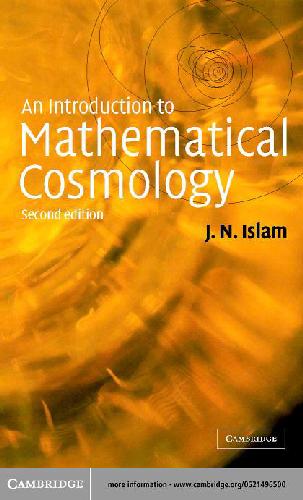

Most ebook files are in PDF format, so you can easily read them using various software such as Foxit Reader or directly on the Google Chrome browser.
Some ebook files are released by publishers in other formats such as .awz, .mobi, .epub, .fb2, etc. You may need to install specific software to read these formats on mobile/PC, such as Calibre.
Please read the tutorial at this link. https://ebooknice.com/page/post?id=faq
We offer FREE conversion to the popular formats you request; however, this may take some time. Therefore, right after payment, please email us, and we will try to provide the service as quickly as possible.
For some exceptional file formats or broken links (if any), please refrain from opening any disputes. Instead, email us first, and we will try to assist within a maximum of 6 hours.
EbookNice Team

Status:
Available0.0
0 reviews
ISBN 10: 0511018495
ISBN 13: 9780511018497
Author: Islam J N
This book provides a concise introduction to the mathematical aspects of the origin, structure and evolution of the universe. The book begins with a brief overview of observational and theoretical cosmology, along with a short introduction to general relativity. It then goes on to discuss Friedmann models, the Hubble constant and deceleration parameter, singularities, the early universe, inflation, quantum cosmology and the distant future of the universe. This edition contains a rigorous derivation of the Robertson–Walker metric. It also discusses the limits to the parameter space through various theoretical and observational constraints, and presents a new inflationary solution for a sixth degree potential. This book is suitable as a textbook for advanced undergraduates and beginning graduate students. It will also be of interest to cosmologists, astrophysicists, applied mathematicians and mathematical physicists.
1 Some basic concepts and an overview of cosmology
2 Introduction to general relativity
2.1 Summary of general relativity
2.2 Some special topics in general relativity
2.2.1 Killing vectors
2.2.2 Tensor densities
2.2.3 Gauss and Stokes theorems
2.2.4 The action principle for gravitation
2.2.5 Some further topics
3 The Robertson?Walker metric
3.1 A simple derivation of the Robertson?Walker metric
3.2 Some geometric properties of the Robertson?Walker metric
3.3 Some kinematic properties of the Robertson?Walker metric
3.4 The Einstein equations for the Robertson?Walker metric
3.5 Rigorous derivation of the Robertson?Walker metric
4 The Friedmann models
4.1 Introduction
4.2 Exact solution for zero pressure
4.3 Solution for pure radiation
4.4 Behaviour near t=0
4.5 Exact solution connecting radiation and matter eras
4.6 The red-shift versus distance relation
4.7 Particle and event horizons
5 The Hubble constant and the deceleration parameter
5.1 Introduction
5.2 Measurement of H0
5.3 Measurement of q0
5.4 Further remarks about observational cosmology
Appendix to Chapter 5
6 Models with a cosmological constant
6.1 Introduction
(i) de Sitter model
(ii) Lema?tre model (Lema?tre, 1927, 1931)
(iii) Eddington?Lema?tre model
6.2 Further remarks about the cosmological constant
6.3 Limits on the cosmological constant
6.4 Some recent developments regarding the cosmological constant and related matters
6.4.1 Introduction
6.4.2 An exact solution with cosmological constant
6.4.3 Restriction of parameter space
7 Singularities in cosmology
7.1 Introduction
7.2 Homogeneous cosmologies
7.3 Some results of general relativistic hydrodynamics
7.4 Defenition of singularities
7.5 An example of a singularity theorem
7.6 An anisotropic model
7.7 The oscillatory approach to singularities
7.8 A singularity-free universe?
8 The early universe
8.1 Introduction
(i) First frame
(ii) Second frame
(iii) Third frame
(iv) Fourth frame
(v) Fifth frame
(vi) Sixth frame
8.2 The very early universe
8.3 Equations in the early universe
8.4 Black-body radiation and the temperature of the early universe
8.5 Evolution of the mass-energy density
(i) 1012K>T>5.5 x109K
(ii) 5.5 x109K>T>109K
(iii) T<109K
8.6 Nucleosynthesis in the early universe
8.7 Further remarks about helium and deuterium
8.8 Neutrino types and masses
9 The very early universe and inflation
9.1 Introduction
9.2 Inflationary models ? qualitative discussion
9.3 Inflationary models ? quantitative description
9.4 An exact inflationary solution
9.5 Further remarks on inflation
9.6 More inflationary solutions
Appendix to Chapter 9
10 Quantum cosmology
10.1 Introduction
10.2 Hamiltonian formalism
10.3 The Schr?dinger functional equation for a scalar field
10.4 A functional differrential equation
10.5 Solution for a scalar field
10.6 The free electromagnetic field
10.7 The Wheeler?De Witt equation
10.8 Path integrals
10.9 Conformal fluctuations
10.10 Further remarks about quantum cosmology
11 The distant future of the universe
11.1 Introduction
11.2 Three ways for a star to die
11.3 Galactic and supergalactic black holes
11.4 Black-hole evaporation
11.5 Slow and subtle changes
11.6 A collapsing universe
introduction to cosmology
an introduction to mathematical cosmology
introduction to cosmology nyu
introduction to cosmology barbara ryden
intro to cosmology
a mathematical introduction to general relativity pdf
Tags: Islam J N, mathematical, cosmology